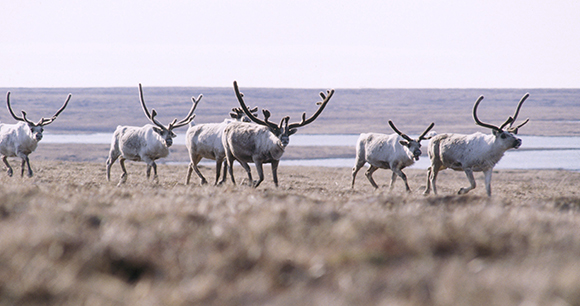by Dr. Joshua Miller
For caribou herds to persist, they must maintain access to productive calving grounds (areas that herds visit annually to give birth to their young). With respect to the Porcupine Caribou Herd (PCH) of the Arctic National Wildlife Refuge, Alaska (ANWR), efforts to fully appreciate how the location of arctic calving grounds have changed through time are complicated both by the logistical challenges of arctic wildlife research and the fact that only a few decades of data are available for study. In fact, a broader temporal perspective may help managers to fully appreciate how the PCH will be impacted by the loss of regions used as calving grounds today, due to stressors such as climate change or the proposed petroleum development in ANWR (which includes the heart of known PCH calving grounds). Caribou bones and antlers lying on the tundra offer a previously untapped source of information to help scientists and wildlife managers gain this perspective. Furthermore, these bones and antlers can be collected without impacting living members of the herd.

Caribou are physiologically unique in that females, like males, annually grow and shed antlers. Male caribou shed their antlers after mating, while pregnant females keep their antlers (which are much smaller) until shedding them within a few days before or after giving birth. Antlers are composed of true bone, which can persist on landscape surfaces for hundreds of years or more. In addition, many newborn caribou do not survive their first 48 hours, adding their skeletal remains to the landscape. With tens of thousands of PCH caribou annually giving birth and shedding antlers on calving grounds, the combined antler and newborn bone record can add dramatically to our understanding of calving ground use and changes through time.
My recent work has shown that areas of ANWR known to be important PCH calving areas have high concentrations of shed female antlers and neonatal skeletons. I have also shown that skeletal records offer high-resolution spatial data on season-specific patterns of landscape use. Furthermore, the state of decay of bones themselves provides information on how long a bone has been weathering (i.e., time since death or shedding) and such information can be used to track population changes through time. With the financial support of a Christine Stevens Wildlife Award from AWI, I am surveying ANWR for female caribou antlers and bones to help map the historical distribution of caribou calving grounds and track their geographic changes through time. This temporally extended perspective will place current patterns of landscape use into a historical context, assess the potential impacts posed by the loss of certain calving areas due to petroleum development, and enhance our understanding of how future climate change will shift the locations of preferred PCH calving grounds.
Beyond the ramifications for the PCH, this study will contribute broadly to arctic conservation and management practices by demonstrating how landscape bone accumulations can provide heretofore untapped sources of historical ecological data that may be collected with minimal impacts to local flora and fauna.
Miller, J. H. 2011. Ghosts of Yellowstone: multi-decadal histories of wildlife populations captured by bones on a modern landscape. PloS ONE 6(3): e18057. doi:10.1371/journal.pone.0018057.
Miller, J. H. 2012. Spatial fidelity of skeletal remains: elk wintering and calving grounds revealed by bones on the Yellowstone landscape. Ecology 93(11): 2474–2482.
Miller, J. H., P. Druckenmiller, and V. Bahn. 2013. Antlers on the Arctic Refuge: capturing multi-generational patterns of calving ground use from bones on the landscape. Proceedings of the Royal Society B: Biological Sciences 280(1759): 20130275.